 Metroid II: Return of Samus is the little-known and underappreciated sequel to one of the greatest and most groundbreaking side-scrollers of all time, the original Metroid, released for the NES in 1986. Metroid 2 seems simple on the surface, yet the gameplay and game mechanics have all been updated and expanded for the better. You can truely consider Metroid 2 to be a game that’s in between the classic-style of the original and the refined greatness of it’s sequel, Super Metroid (which is Metroid 3).
Metroid II: Return of Samus is the little-known and underappreciated sequel to one of the greatest and most groundbreaking side-scrollers of all time, the original Metroid, released for the NES in 1986. Metroid 2 seems simple on the surface, yet the gameplay and game mechanics have all been updated and expanded for the better. You can truely consider Metroid 2 to be a game that’s in between the classic-style of the original and the refined greatness of it’s sequel, Super Metroid (which is Metroid 3).
Some iconic Metroid power-ups even made their debut in Metroid 2, namely the Spider-Ball and Space Jump abilities. Yet many people may wonder if Metroid II is really a good enough game for them to track down and buy in this day an age (it being a monochrome black & white original Game Boy game after all)?
Well that’s what this review is for! So get ready to enter the world of Samus Aran once again as we delve into the depths of SR388. And in case you missed it, see my reviews for the original Metroid and it’s remake, Metroid: Zero Mission.
Metroid 2: Return of Samus
System: Game Boy
Released: 1992
Players: 1
Link Up?: No
Save: Cartridge (three files)
Developer: Nintendo
Publisher: Nintendo
Creator: Gunpei Yokoi
Metroid II: Return of Samus is the sequel to the original “Metroid” that came out on the NES in 1986. Five years later, Nintendo debuted their new portable system, the Game Boy, and not long after, a killer-app was released: a brand new Metroid title.
So how does Metroid II stack up to the original? Unfortunately, this game simply isn’t as memorable as it’s predecessor. Sure it’s an excellent original Game Boy title, but, especially nowadays, it simply can’t stack up. Due in a large part to all the hardware limitations of the Game Boy system, which actually wasn’t even as powerful as the system Metroid originally debuted on, the NES.
 Amazingly though, this game manages to somehow contain a lot of what made Metroid such a cool game, even on such underpowered hardware. The action is just as good as the original Metroid, and the controls and physics are spot-on. Metroid II actually makes many enhancements to the original that, while seemingly simple in nature, add a lot in differentiating this game from the original.
Amazingly though, this game manages to somehow contain a lot of what made Metroid such a cool game, even on such underpowered hardware. The action is just as good as the original Metroid, and the controls and physics are spot-on. Metroid II actually makes many enhancements to the original that, while seemingly simple in nature, add a lot in differentiating this game from the original.
Samus can finally duck (HALLELUIAH!), which makes it easier to dodge enemies and destroy low blocks, and Samus can also now shoot downwards by jumping. Sure, it doesn’t sound like much, but that, combined with Samus’ more human, taller look, simply give the game a somewhat different feel when your running around as Samus. She looks more like an actual human than a simplistic looking sprite, and she is much more detailed.
 Going much further in enhancing the gameplay, and probably the best thing about Metroid II: Return of Samus over the original, are all the highly original power-ups that have been added to this installment. Amazingly, Metroid II has probably around twice the weapons and abilities that you can gain over the original. An amazing feat when you consider the hardware and limitations Nintendo had to work with.
Going much further in enhancing the gameplay, and probably the best thing about Metroid II: Return of Samus over the original, are all the highly original power-ups that have been added to this installment. Amazingly, Metroid II has probably around twice the weapons and abilities that you can gain over the original. An amazing feat when you consider the hardware and limitations Nintendo had to work with.
Not only do you get all the weapons and items from the original (Morph Ball, Bombs, Missiles, Ice Beam, Wave Beam, Varia Suit, Screw Attack, High Jump Boots. The Long Beam has been eliminated and Samus now shoots far shots that reach the end of the screen by default) but many of the really cool iconic Metroid franchise weapons and abilities, that are now standard and beloved by fans everywhere, made their series’ debut in Metroid II.
 You get the “Spider-Ball”, which allows you to climb walls while in “Morph Ball” mode by pressing down, something that seems like it could break a game like this with such small corridors and open rooms. Amazingly it doesn’t, and it simply adds that much more to the exploration element since you can now explore the roofs and sides of rooms.
You get the “Spider-Ball”, which allows you to climb walls while in “Morph Ball” mode by pressing down, something that seems like it could break a game like this with such small corridors and open rooms. Amazingly it doesn’t, and it simply adds that much more to the exploration element since you can now explore the roofs and sides of rooms.
Metroid II was also the debut of the famed “Space Jump” maneuver. This power-up gives Samus the ability to continuously flip through the air, and when combined with the “Screw Attack”, turns Samus’ flip into a weapon, allowing you to destroy enemies by flipping into them.
Other weapons that made their debut in Metroid II are the “Spazer” and “Plasma” Beams. The former is a three-beam shot that is more powerful than “Ice” or “Power” (Power is Samus’ default weapon) Beams, and the latter is the most powerful beam weapon, a single-line shot that can destroy most enemies in one hit.

And the last Metroid standby to make it’s debut in Metroid 2 is the “Spring Ball” ability. This is another very nifty power-up that allows Samus to “jump” while in Morph Ball mode, useful to enter small spaces that are three or so blocks high, which are difficult to bomb yourself up to.
So Metroid II largely contains the same fun gameplay that made the original Metroid such a hit, while significantly updating it and making it feel more tweaked and fresh with “logical” additions (being able to duck and shoot downwards) and nifty new abilities for Samus to acquire (Like the Spider-Ball and Space Jump).
 The premise of this game is different as well, and the storyline takes place directly after the original, in which Samus, after destroying the Space Pirates’ base of operations on the fortress planet Zebes, is sent in once again by the Galactic Police. This time it is to the Metroid’s home world, the planet SR388. And Samus’ mission is to eliminate the Metroid threat once and for all; by destroying each and every Metroid on the entire planet, and eventually taking out their leader, the Metroid Queen.
The premise of this game is different as well, and the storyline takes place directly after the original, in which Samus, after destroying the Space Pirates’ base of operations on the fortress planet Zebes, is sent in once again by the Galactic Police. This time it is to the Metroid’s home world, the planet SR388. And Samus’ mission is to eliminate the Metroid threat once and for all; by destroying each and every Metroid on the entire planet, and eventually taking out their leader, the Metroid Queen.

Thus, instead of just exploring a large world destroying enemies and locating the two bosses & Mother Brain, like in the original, in Metroid II you start out with a total of 30 Metroids, and your task is to search the world and destroy each and every one (they can only be killed using missiles). As you destroy Metroid’s, the acid that hinders your progress will drain; giving you further access to the rest of the world, allowing you to go deeper and deeper into the planet.
 And as you make progress, you’ll begin to come into contact with stronger and stronger enemies and more powerful Metroids. Not only do you fight regular Metroids in Metroid II, but there are now several (four in total) different Metroid forms, each of which gets more powerful and harder to destroy (the later ones look like something ripped right out of the “Alien” flicks).
And as you make progress, you’ll begin to come into contact with stronger and stronger enemies and more powerful Metroids. Not only do you fight regular Metroids in Metroid II, but there are now several (four in total) different Metroid forms, each of which gets more powerful and harder to destroy (the later ones look like something ripped right out of the “Alien” flicks).
Now, this is the year 2006, and by reading the above, you may be getting a really cool picture in your head. But remember, this game came out in 1991 on the very weak, monochrome (a.k.a. black & white) original Game Boy.
So, what am I trying to say? I am saying not to expect much graphic or music-wise. The graphics in Metroid II are good for such an old title, but today they are simply extremely outdated. And while they are just as detailed (and sometimes more so) than the graphics in the original, that little bit of luster that the graphics have is all but lost due to the lack of any color. While a lack of color doesn’t seem like it would change the gameplay one-bit, it does somewhat effect it by making areas less recognizable.
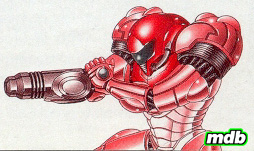
Thankfully Metroid 2 makes many enhancements over the original feature-wise, addressing many antiqued complaints the original had. You can now save your game to the built-in battery-pack memory, which means no more super long, mega complex, insane passwords like in the original Metroid and there are three total save files.
 And addressing one of my biggest complaints with the original game, there are now items scattered around the world that, when touched, will completely refill your energy and missiles (the original lacked this feature making it nearly impossible to regain your life & missiles if you died), and these things make the game much less frustrating (albeit, somewhat easier).
And addressing one of my biggest complaints with the original game, there are now items scattered around the world that, when touched, will completely refill your energy and missiles (the original lacked this feature making it nearly impossible to regain your life & missiles if you died), and these things make the game much less frustrating (albeit, somewhat easier).
Sadly though, there is still ONE major feature missing from Metroid II, that would have made the game a lot easier to pick up & play, and a lot less frustrating to finish. That feature is . . . a map. There is absolutely NO map for any area in Metroid II. This may not seem like a big deal on the surface, but think of what this means: picture the original Metroid, and how hard it was to remember where you were going, needed to go, and/or came from. Now, do the same thing here, except make it black & white.
 Also, here, no matter how varied the different areas are, they STILL aren’t different enough. To the point where many a time you will come across parts of an area (there are no “levels” in Metroid) that look EXACTLY the same as others. This makes the game very difficult, as if you aren’t keeping track of the general layout, and where you came from, you can EASILY get lost. And if you don’t remember what you already did beforehand (as in, you haven’t played the game in a while, and you wouldn’t recognize places you’ve been too), the game can be almost impossible to pick up and continue with since you won’t know where to go or remember where you have been.
Also, here, no matter how varied the different areas are, they STILL aren’t different enough. To the point where many a time you will come across parts of an area (there are no “levels” in Metroid) that look EXACTLY the same as others. This makes the game very difficult, as if you aren’t keeping track of the general layout, and where you came from, you can EASILY get lost. And if you don’t remember what you already did beforehand (as in, you haven’t played the game in a while, and you wouldn’t recognize places you’ve been too), the game can be almost impossible to pick up and continue with since you won’t know where to go or remember where you have been.
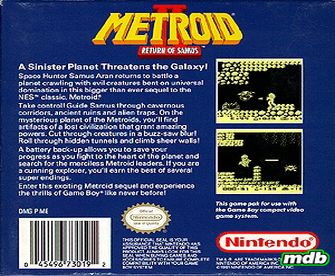
However, Metroid II does do as good a job as can be expected even without a map. By pausing the game, you can see how many Metroids are left in the current area on the bottom right of the screen (where it tells you how many TOTAL Metroids are left in the game when unpaused). And you can pretty much be able to tell which area needs to be explored since you only go “deeper” (as in, down) as you explore and open up areas. Climbing upwards will lead “back”, cause you are going towards the surface. Climbing downwards will make you progress in the direction you need to go as you delve deeper into the depths of the planet.
 Thus, you will come across acid that blocks your path from going any deeper. From this, you will know that the areas “upward” of you have already been explored and cleared of Metroids, while the areas close to the acid is probably where you need to go.
Thus, you will come across acid that blocks your path from going any deeper. From this, you will know that the areas “upward” of you have already been explored and cleared of Metroids, while the areas close to the acid is probably where you need to go.
And you can also tell when you’ve entered a new area outside of the main “overworld”, by the music. The main theme will play when you are in the “overworld”, and when you enter an area that needs to be cleared of Metroids, the music will nearly cut-out and the music will be more low-key. This does help a lot, but even so, the areas are often large and full of rooms that look nearly identical (and remember that you will be exploring the walls and roofs via your Spider-Ball. So Metroid 2 isn’t confined to the ground). So making a mental note of where you are going and where you have been to already is almost a necessity in this game, where the world truely is a labryinth.
 Speaking of music, Metroid II once again suffers due to the limitations in the hardware that the developers had to work with. The main theme and title screen music are the only real stand-outs. The rest of the music is very low-key, and doesn’t stick with you at all.
Speaking of music, Metroid II once again suffers due to the limitations in the hardware that the developers had to work with. The main theme and title screen music are the only real stand-outs. The rest of the music is very low-key, and doesn’t stick with you at all.
This is a far cry from the music in the original Metroid, which really set the mood, and made you feel like you were exploring a mysterious world full of hidden secrets and dangers. The music in the original was at times haunting and unsettling, especially way back then, an could do a number on your psyche, just giving you an uneasy feeling. The mood is all but completely lost here and the music isn’t memorable in the least, unlike the original, where most of the music is beloved by video game music fans everywhere. Which is definitely disappointing.
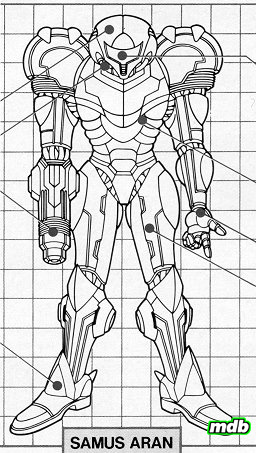 While music almost seems like a “make or break” feature in a Metroid game, luckily the gameplay here stands up well and will soon have you forgetting all about the music. The exploration element that makes Metroid such a fantastic action / adventure game is still maintained and here in spades, and the action is really a lot better than in the original, feeling more refined. You will also feel empowered as you find more and more weapons and abilities, something that all Metroid games share, and this one is no exception.
While music almost seems like a “make or break” feature in a Metroid game, luckily the gameplay here stands up well and will soon have you forgetting all about the music. The exploration element that makes Metroid such a fantastic action / adventure game is still maintained and here in spades, and the action is really a lot better than in the original, feeling more refined. You will also feel empowered as you find more and more weapons and abilities, something that all Metroid games share, and this one is no exception.
So, what’s the final verdict? Metroid II: Return of Samus is an excellent Game Boy title (that is, original GB). It has, like the original Metroid, withstood the test of time, even if it still feels really outdated. A good game is still a good game, no matter how you slice it, and no matter how long it’s been since you last played it or since it was released, Metroid 2 is still a good game.
Having said that, Metroid II lacks one crucial element that every other Metroid game has shared, and sadly, this is due more to the limitations of the Game Boy hardware, than by design itself, as the developers worked wonders with what they had to work with on underpowered hardware. But even so, there’s no changing the fact that Metroid II simply isn’t as memorable as it’s predecessors or it’s sequels.
 It is far from forgetable, as you will remember it for it’s unique and awesome power-ups (Spider-Ball, Space Jump), and for containing what is arguably the most unique premise of the 2D Metroid titles, having to hunt down all the Metroids on the planet and fighting their various forms. The end-boss is also really cool, and the storyline is nice (even though none of it is translated in-game, except at the end and through the instruction manual, which most people in this day & age won’t have access too. But you may be able to find online) but when compared to other Metroids, it lacks “great moments”.
It is far from forgetable, as you will remember it for it’s unique and awesome power-ups (Spider-Ball, Space Jump), and for containing what is arguably the most unique premise of the 2D Metroid titles, having to hunt down all the Metroids on the planet and fighting their various forms. The end-boss is also really cool, and the storyline is nice (even though none of it is translated in-game, except at the end and through the instruction manual, which most people in this day & age won’t have access too. But you may be able to find online) but when compared to other Metroids, it lacks “great moments”.
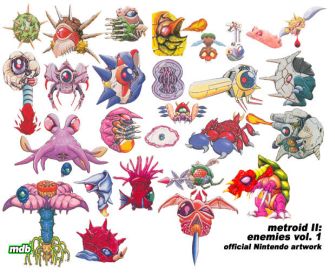
Overall, Metroid II stands with the best Game Boy titles of all time (right up there with Pokemon, Tetris and Zelda: Link’s Awakening), yet in the grand scheme of things, this makes it easily the “worst” Metroid title.
So, is the game worth tracking down and buying?
If you consider yourself a big fan of the Metroid games, then that is a definite yes. It’s worth it just to see how far the series has come since (especially after playing Zero Mission), how the developers ingeniously used every bit of power they could get from the Game Boy system, and yet still provide you with fun gameplay and unique weapons & items. But if you aren’t someone who is big on the Metroid series, you’re probably just as well off skipping Metroid II entirely. Especially if you never played the original Metroid and were weaned on the smooth & ultra-polished gameplay of it’s sequels: Super Metroid, Metroid Fusion, Metroid Prime or Metroid: Zero Mission (which is a remake of the original). Metroid II is a great Game Boy game, but sadly, that only makes for a “good” Metroid game.
 Ratings
Ratings
Then: 8.5 (what I would give the game on it’s own merits as an original Game Boy title)
Now: 7.5
As much as I want to say that Metroid II is great, that’s really giving it too much credit. It’s extremely outdated, and lacks a major feature that would have made the game a lot less frustrating, and that is any form of map or guide. Nonetheless the game is DEFINITELY very good. About as good as you can get on the original GB and definitely worth tracking down for hardcore Metroid fans.
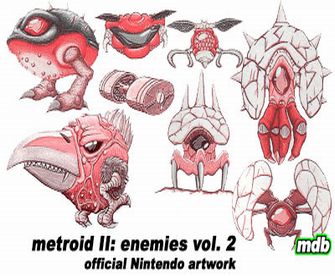
For everyone else, plucking down the $20 or so it would take to get the game (that is, if you can even find it. And unless you are extremely lucky, it won’t come with the instruction booklet or box) is simply asking too much. For the same price you could get something that’s much more modern, and will provide you with a lot more replay value and bang for your buck.
On it’s own Game Boy terms
Fun Factor: 8.0 – This is a fun game in the same vein as all other Metroids and the exploration aspect and the fact you can explore the walls and roofs of areas makes it fun to search.
Graphics: 8.0 – Samus is nice, tall and detailed, and the environments are varied for what they had to work with.
Music & Sound: 5.5 – Nice main theme and title screen music, everything else is mainly just filler. It does however contain the staple Metroid sounds but lacks memorable music.
 Replay Value: 6.5 – Good luck beating the game in under two hours to see Samus’ w/out her suit. And unless you explore a lot you won’t find all the items. However, even so, beating the game once is likely all you’ll need to be satisfied unless you are a hardcore Metroid fan.
Replay Value: 6.5 – Good luck beating the game in under two hours to see Samus’ w/out her suit. And unless you explore a lot you won’t find all the items. However, even so, beating the game once is likely all you’ll need to be satisfied unless you are a hardcore Metroid fan.
Ingenuity: 8.0 – Added a lot of great features to the Metroid series, including the debut of many beloved power-ups that would make return appearances in future Metroid titles.
Playability: 6.0 – This is a hard game to finish. Lack of any sort of map is the main culprit, leaving you to mentally figure out the layout. Unless you are an old-school gamer weaned on systems before the SNES/Genesis era, you will likely have a hard time enjoying this game, let alone beating it.
Presentation: n/a – This doesn’t even really apply, since games this old didn’t need much presentation. The game is as straight forward as they come, and you’ll likely be able to figure out how to play it within’ a couple minutes.

